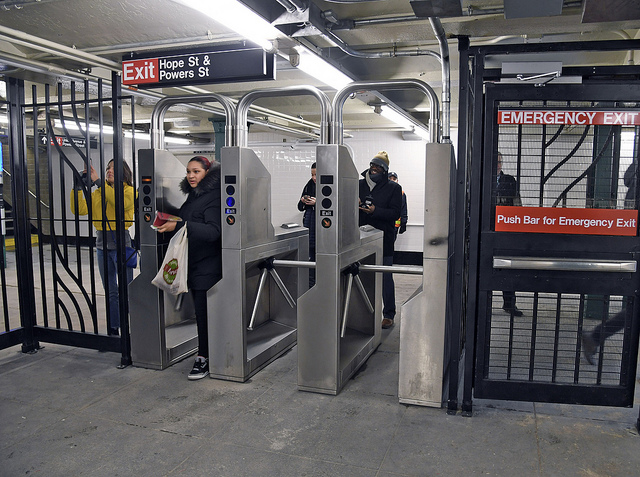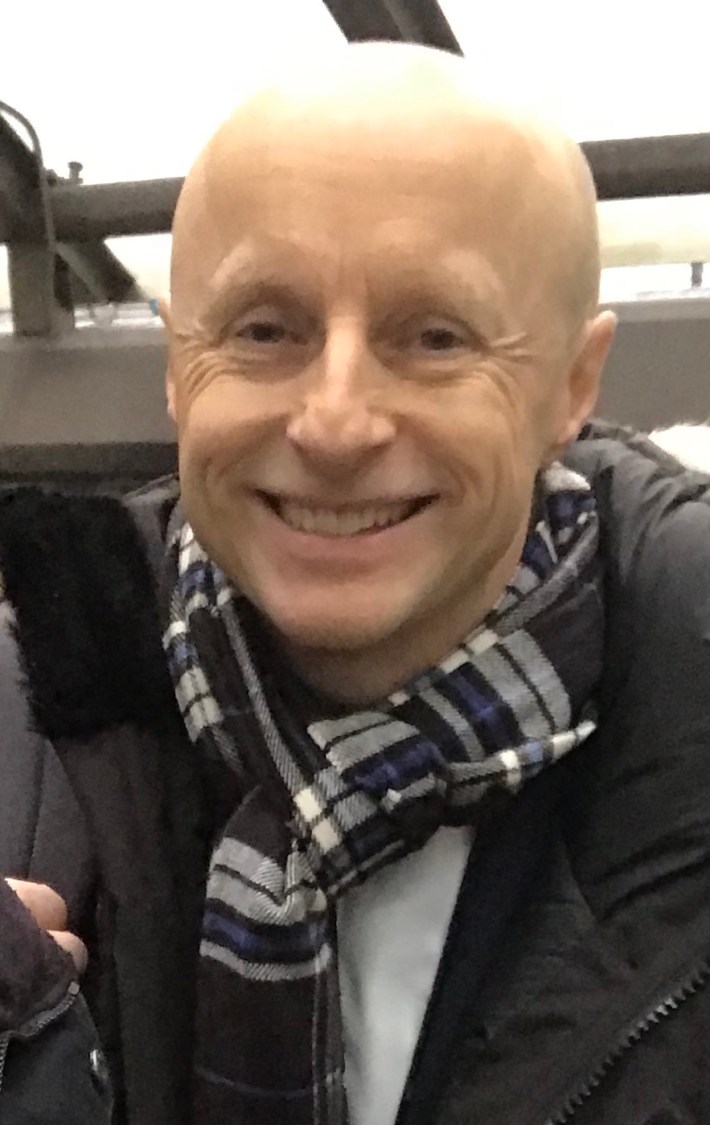So much for "bus and frisk."
Facing an outcry from transit and equity advocates, the MTA on Wednesday walked back a plan to target fare evasion by putting "more cops on buses" — a comment that raised the specter of the NYPD's reviled, repudiated and ultimately rejected stop-and-frisk program from the Bloomberg Administration.
"We are absolutely opposed to unfair enforcement, which is why our efforts are so focused on prevention and deterrence, not arrests," MTA spokesman Maxwell Young told Streetsblog. "We have proposed a wide range of solutions that include enhanced video technology, additional New York City Transit personnel in fare-paying areas, all-door boarding through our new fare payment system and more."
Young's comments were designed to calm a firestorm of protest after New York City Transit President Andy Byford said on Monday that fare evasion had reached “wholly unacceptable levels” requiring the enforcement effort of the NYPD.
“Going forward into the future, the big thing that is missing is we need cops on buses,” said Byford, a London native who came to New York only last year after stints in Canada and Australia and might not be fully aware of the NYPD's legacy of racially biased enforcement. Under the NYPD's stop-and-frisk program, in 2011, 685,724 people were stopped on the street, the vast majority people of color — the vast majority of whom had done nothing wrong.
The MTA board's interim chairman Freddy Ferrer is quite aware of the stop-and-frisk back story, having once called it "racial profiling" in a mayoral debate. As such, he also walked back Byford's comment — as did Byford.
“The point is not to have a police officer on every bus — to criminalize everything," he said. "The point is to try to enforce the law. The object here is… to get people to comply. It’s not like when you go to a museum and there’s a suggested donation."
"If what we do… by positioning staff, maybe police officers, as a deterrent, means that people then don’t chance it, don’t evade the fare, fantastic," Byford told reporters following Ferrer's comments. "I’d love it if no one actually got caught. I would rather if just the deterrents and the cameras and everything else we’re talking about actually meant that everyone pays their way."
Byford's original comments addressed a growing concern. On Monday, the MTA issued new findings that one in five bus riders avoid paying fares [PDF]. Combined with subway turnstile jumpers, who accounted for 3.4 percent of riders in the fourth quarter of 2018, the MTA estimates losing $225 million per year as a result of farebeating.
The call for more police presence on local buses earned kudos from MTA board members, who must close a growing operating deficit. But it drew ire from advocates for the poor, several first-term lawmakers, and transit riders themselves — all of whom stressed that the overwhelming majority of people arrested for fare evasion are people of color. Stop-and-frisk also suffered from that bias. Seventy-five percent of bus riders are people of color, with a median income of $28,455, statistics show.
"We need mass transit that moves people, not one that seeks to lock them up," Bay Ridge Senator Andrew Gounardes said in a statement. "Rather than criminalizing poverty and placing already overburdened police officers on already overcrowded buses, the MTA should be focusing on expanding all-door boarding options on all bus lines, which has already been shown to limit fare evasion on SBS routes."
State Senator Jessica Ramos of Jackson Heights added in a tweet: "We do not need more police. We need good jobs. Stop criminalizing the poor!"
My crazy (not so crazy?) view is that the local buses in NYC should probably be free. https://t.co/M2hSSWUMFD
— Second Ave. Sagas (@2AvSagas) March 25, 2019
Byford had not anticipated those concerns during his 15-minute fare evasion presentation on Monday — but by Wednesday morning's MTA board meeting, they were front and center. Gounardes and Ramos' comments were echoed by transit advocates, who stressed that the MTA's fare evasion strategy should be focused on moving past archaic Metrocard technology, not punitive measures.
"Sharpen your focus on improving bus service and bringing riders the faster and more reliable bus service they deserve," TransitCenter Deputy Executive Director Tabitha Decker told board members.
Decker pointed to the importance of all-door boarding and modern fare-card technology in incentivizing riders to pay their fares. Evasion rates are significantly lower on Select Bus Service routes, where fares are collected off-board and enforced by non-NYPD security agents.
"Buses are not working. They're failing riders. Bus service has been neglected for years," added Riders Alliance senior organizer Stephanie Burgos-Veras. "Let's invest our energy wisely. Let's focus on improving the lives of our bus riders and not [on] criminalizing poverty."
On Monday, Byford also announced plans to test-run having the "Eagle" teams that enforce on SBS also patrol local routes.
A closer inspection of New York City Transit's fare evasion data raises more questions than it answers. The data do show a clear increase in fare evasion — but only as the MTA measures it, through visual surveys of key bus routes and subway stations. That data is then extrapolated for the entire system.
That method is unsatisfactory in showing the actual extent of the problem, according to an official privy to New York City Transit's fare evasion discussion.
"Given the methodology ... for the most part, we know that, yes, the fare evasion rate probably went up," the source told Streetsblog. "But if you really look at the survey, you can’t look at the data and make bold pronouncements from them — you can’t. But timid pronouncements don’t move things politically."
Meanwhile, the agency has not measured whether using police to hunt down fare evaders would even re-coup the money the agency supposedly loses.
It also has no data on when fare evasion occurs, where fare evasion occurs, or the demographics of fare evaders — key factors that would shape the impact and ramifications on an increase in enforcement. Students, for example, pile into buses en masse in the hour before school starts, obscuring access to the fare machine and forcing riders to enter through the back door.
"Byford is missing an essential part of what it's like to try to ride a bus in the hour before school begins," said Seth Pearce, a public school teacher in Brooklyn. "He is suggesting police, when what we really need is more busses, more often."
Facing massive budget shortfalls, the MTA is scraping for money — and fare evasion is an easy scapegoat.
“You see this in a lot of places. Theft of services becomes an issue to explain away structural issues," said CUNY professor Kafui Attoh, who has researched transportation access for the poor in other cities.
Byford, however, is resolute. Here was his full response:
I think the impression given is that we’re only focusing on evaders. That’s simply not the case. One full quarter of Fast Forward is devoted to improving the bus service in this city… That’s my focus. A positive focus. But I don’t see these two things as binary. It’s not either fare evasion or improve the bus network… It’s not binary. I just don’t think it’s right to let over $250 million of revenue, which could into putting in elevators, improving service, myriad other things — improve cleanliness. We can’t just ignore that. If anything, we probably underplay the amount of fare evasion with the techniques that we’ve got. You only have to ride the system, as I do every day, to see people pouring up. And I’m sorry I don’t actually buy the fact that it’s because is necessarily round. People just get on the back door sometimes when actually the bus isn’t that full.
I would love it if no one was found guilty of fare evasion. If what we do… by positioning staff, maybe police officers, as a deterrent, means that people then don’t chance it, don’t evade the fare, fantastic. Job done. Right? Because then no one get criminalized. We don’t want that. All we want, because it’s fair to the majority. We want people to pay their fare.We heard that loud and clear at the fare [increase] meetings. People said, I’m fed up with this, I pay my fair, why shouldn’t other people. That’s all we’re talking about, right? I’d love it if no one actually got caught. I would rather if just the deterrents and the cameras and everything else we’re talking about actually meant that everyone pays their way.







